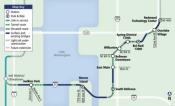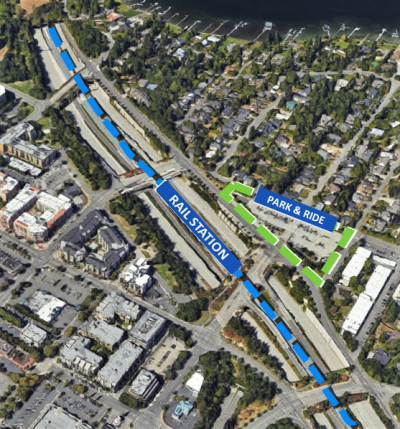Light Rail (East Link)
Overview & Background
East Link is a voter-approved project to expand light rail from downtown Seattle to the Eastside with stations serving Mercer Island, south Bellevue, downtown Bellevue, Bel-Red, and Redmond's Overlake area. The expected opening date has been adjusted from late 2023 to spring 2025 due to construction issues. East Link will connect to the Central Link light rail line already operating between Seattle and Sea-Tac Airport. Learn more about opening delays from Sound Transit.
Central Link opened an extension to the University of Washington in early 2016, and a further extension to Northgate opened in October 2021. Initial East Link construction began in Bellevue in April 2016, and on Mercer Island in June 2017. In November 2021, Sound Transit reopened the South Bellevue Park & Ride to commuters, providing additional parking options; rail station construction continues at that location. Sign up for Sound Transit Construction Alerts here.
You can view the location of the Mercer Island station and the Park & Ride in the aerial photo (click to enlarge).
According to Sound Transit, the Eastside is one of the region's fastest growing economic and residential centers, but job and population growth are putting increasing demand on the Eastside's transportation system. East Link will provide an alternative to driving on congested roads: because light rail trains operate in their own right-of-way, they provide fast, smooth and reliable service no matter what the weather or traffic conditions. East Link will connect directly to the Central Link light rail line for a no-transfer ride between Redmond, Bellevue, Mercer Island and the University of Washington via downtown Seattle and Capitol Hill.
Ride Times: A ride from Mercer Island to the International District will take 10 minutes, to the UW Campus will take 21 minutes, and to SeaTac Airport will take 46 minutes (with transfer).
The trackway will run across the center roadway floating bridge between Seattle and Mercer Island, and will displace permanently all vehicle traffic onto the mainline roadways. To partially compensate for the lane closures, WSDOT installed HOV lanes in each direction of mainline I-90, under a project known as R8A-Stage 3. In May 2017, the City Council accepted a settlement offer of $10 million in mitigation payments from Sound Transit to compensate for the impacts from rail construction and the permanent loss of access to the express lanes on the now-closed center roadway. View Settlement Agreement.

What's Happening Now
Visit Sound Transit's East Link webpage for the latest construction updates. To learn about specific Mercer Island-related issues and topics, visit the City's light rail outreach page.
Get Involved
A series of public input opportunities occurred starting in 2015; click here for presentation materials and summary comments from Sound Transit's Mercer Island webpage.
The City held a community open house in November 2016 to update the public on ongoing negotiations with Sound Transit, WSDOT, and the Federal Highway Administration (FHWA), and to solicit input on future vehicle access to I-90 during light rail construction. Additional community listening sessions about rail issues have occurred throughout spring 2017 with various stakeholder groups. Learn more about community meetings here.
Sound Transit held its customary construction kickoff open house meeting on July 12, 2017.
Project Schedule
- WSDOT closed the I-90 center roadway on June 3, 2017 to start light rail construction
- In the summer of 2018, the Rainier Ave Freeway bus station closed for Judkins Park station construction. Regional ST buses from MI to downtown Seattle exit at Rainier Ave
- Construction of the MI Station will be mostly complete by late 2020
- Construction of the Bus-Rail Interchange (Roundabout) on 77th Ave NE, and the entrance plaza on 80th Ave NE occurs throughout 2022
- In early 2022, Sound Transit announces construction challenges and related delays. Light Rail is now scheduled to open for service in spring 2025.
The Environmental Process
In fall 2006, Sound Transit, the Federal Transit Administration and the Washington State Department of Transportation began the environmental review process for East Link with a public scoping comment period including four public meetings held at various locations in the project's vicinity. During scoping, Sound Transit received about 300 written and oral comments on the proposed project. These comments were included in the Scoping Summary Report, which was presented to the Sound Transit Board and made available to the public in November 2006.
From 2006-2011, Sound Transit evaluated 24 route alternatives for East Link; it received more than 1,800 comments during the five year process and held 28 open houses, hearings and workshops to gather community input.
Environmental review and preliminary engineering for East Link Extension was completed in 2011. Sound Transit issued a Final Environmental Impact Statement (FEIS) and the Sound Transit Board selected the project to be built in July 2011. The Federally issued Record Of Decisions (ROD) finalized the alignment that the Sound Transit Board selected through this work, completing the required process under the National Environmental Policy Act.
On April 5, 2017, Sound Transit and WSDOT issued an Addendum that updates the Final Environmental Impact Statement (EIS) issued in July 2011 --and subsequent 2013 and 2016 addenda-- by providing additional analysis and information about the project. It describes changes in operation of I-90 high-occupancy vehicle (HOV) lanes and project refinements associated with transit integration on Mercer Island, evaluates the potential impacts of these changes, and identifies changes to mitigation measures.
View the 2017 Addendum pages here.
Click here to view the East Link 2011 Final Environmental Impact Statement (FEIS) web portal.
What is Light Rail?
Light rail is versatile and flexible enough to run at street level, through tunnels, or in elevated right-of-way, depending on individual routes. It also can expand and grow with increasing demand. Light rail trains are powered by an overhead electrical power source. Sound Transit's Link light rail vehicles offer level boarding (no steps required) that can operate singly or combined into two-, three- and four-car trains that can carry up to 800-1,000 passengers, sitting and standing.
Sound Transit's Transportation Network
Link light rail is a key element of the Puget Sound region's long-term transportation network, which also includes ST Express regional buses, Sounder commuter trains, local buses, ferries and roads.
Benefits of Link Light Rail
According to Sound Transit, here are some of the top expected benefits:
- Fast, frequent and reliable service up to 20 hours a day.
- One train every 8 minutes during peak hours.
- Exclusive and semi-exclusive right-of-way for rail transit, separated from other traffic and congestion
- East Link will connect to the Central Link line providing a one-seat ride (no transfers) from Overlake to the University of Washington via Bellevue, Mercer Island, downtown Seattle and Capitol Hill
- Reliable connection to Sea-Tac Airport
- Light rail trains are electric and do not emit harmful contaminants into the air
- Development concentrated around light rail stations promotes walkable communities, which leads to improved public health and mobility
- Light rail can carry crowds associated with fairs, sporting events, concerts, festivals, and other special events; trains can be lengthened based on demand.
Click here to view Sound Transit's full East Link project archive webpage.

